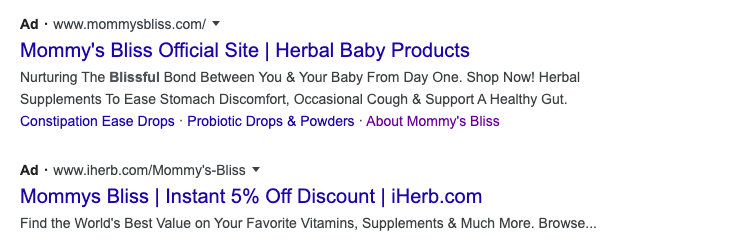This post has been updated and was originally published in November 2020.
Get expert tips for creating successful healthcare PPC marketing campaigns in this highly regulated industry.
Here, you’ll find:
- How healthcare marketers can leverage paid search
- Regulations for healthcare-related ads
- The latest data surrounding healthcare pay-per-click (PPC) ads
- Tips for standing out from industry competition
Marketers experienced in the healthcare space know that it can be, in a word, finicky — even when there’s not a pandemic.
For that, you can thank Google’s core algorithm updates in recent years. At times, these updates have thrown the industry into near-chaos, with some sites losing nearly all of their traffic while others see huge growths.
Because of this unpredictability, it makes sense that marketers would turn to healthcare PPC. Not only does paid search allow for audience targeting, but it can help you get to the top of the search engine results page (SERP) more quickly than relying on SEO and organic rankings alone.
Google Trends shows health-related searches nearly doubled across the U.S. between December 2019 and March 2020 (we’re guessing COVID-19 had something to do with that). And back in 2020, NewsCred predicted that voice searches for healthcare topics would continue to rise as smart speakers enter more than half of U.S. homes by 2022.
Add to that the Moz data showing the #1 positioned organic search results are now further down the page than the worst-case scenario positioning in 2013, and it’s clear paid search can be more beneficial than ever.
For best practices when it comes to healthcare PPC, read on.

Read over the ad guidelines so you can make sure you’re not spending time on a campaign that’ll end up getting rejected or pulled. (Image via Unsplash)
1. Understand the healthcare paid search regulations
Because healthcare is such a highly regulated industry, it makes sense that paid search guidelines would be, too. Luckily, both Google and Microsoft Advertising (formerly Bing Ads) have published clear parameters when it comes to this kind of ad content.
For example, Google only allows pharmaceutical manufacturers to advertise in Canada, New Zealand, and the United States (over-the-counter meds have a much longer list).
Additionally, they now prohibit pharmaceutical manufacturers from promoting prescription opioid painkillers or targeting locations where they aren’t licensed. You can use the handy drop-down menu to see which types of PPC ads are allowed in each country.
Google’s healthcare paid search ad policies include regulations related to:
- Restricted drug terms
- Unapproved substances
- Unauthorized pharmacies
- Speculative and experimental medical treatments
- Clinical trial recruitment
- Addiction services
It’s also good to be aware of Google’s “health in personalized advertising” limitation on personal health content. Even if you comply with its healthcare guidelines, Google can limit how often your ads appear based on what your company aims to treat.
For example, an audiologist may be limited because Google considers hearing loss a chronic condition.
2. Get familiar with LegitScript
Microsoft states that their policy on pharmaceutical products in particular “varies by market.” As such, those advertising drug or alcohol addiction services (rehab facilities, group therapy, and halfway houses, for example) must be certified by a company called LegitScript first.
LegitScript can take a while to get approved and should be done before the campaign is built out. This approval needs to be done if there’s any prescriptions on your site or addiction services.
For example, any mention of Botox will cause your site to get flagged if you don’t have LegitScript approval, even if you aren’t targeting Botox in your keywords. This is common for businesses such as medical spas.
Some industries have regulations about using words like “best” and “will” — think: copy such as “the best healthcare” and “we will cure your pain.” Google won’t necessarily flag this, but it could cause problems for the client. That’s why we say it’s best practice to avoid it.

A Microsoft Advertising verbiage example
Microsoft’s healthcare paid search ad policies include regulations related to:
- Invasive treatments and cosmetic surgery
- Weight loss
- Pharmacy and prescription-only medicine
- Non-prescription medications and health supplements
- Family planning
No matter which part of the healthcare umbrella your company falls under, it’s a good idea to read over these guidelines. This way, you can make sure you’re not spending time on a campaign that’ll end up getting rejected or pulled.
Pro tip: Currently, Google classifies CBD under the “Unapproved pharmaceuticals and supplements” category. Thus, any mention of it on your site will get it flagged and/or disapproved.
3. Be easily reachable
This may sound like a no-brainer, but you’d be surprised to see how many companies (across multiple industries) make it difficult to get in touch with them. What’s a lead to do? In this case, they’ll likely keep scrolling to find a brand with a phone number, live chat, or address more readily available.
Setting up a call extension and location extension on your ad is a great first step. It’s also wise to include your contact info on each website page as well as your landing pages and even your social media profiles. This makes it easier for people to reach out to you quickly, no matter where they land.
Pro tip: If one of your main goals is to drive people to your location, don’t forget about correctly setting up your Google My Business profile. This can help increase local customer engagement across Google Maps and searches.
4. Focus on E-A-T
Yes, this is an SEO term. But the idea behind it can be quite beneficial when it comes to healthcare PPC as well. (If you’re not familiar, E-A-T stands for expertise, authority, and trustworthiness.)
E-A-T was first introduced in 2015 via a Google Search Quality Evaluator Guidelines document that explained how the search engine gauges website quality. It was brought up again in 2018 when these guidelines expanded to also include content authors.
With the stiff competition — plus a focus on hard data and proven science — that comes with the healthcare industry, keeping E-A-T in mind when you’re creating ad copy and landing page content can be what sets your brand apart from the rest.
5. Keep your message simple
Picture it: You’re frantically searching for the meaning of certain symptoms or the nearest urgent care facility. You’re probably not in the mood for quirky headlines or sensationalist claims.
The most effective healthcare paid search messaging is clear and direct. Your ad will have the best shot at cutting through the clutter by speaking your audience’s language and being concise about what you’re offering. Sometimes a simple question, such as “Looking for a speedy urgent care center in Atlanta?” is all it takes.

Straightforward ad copy from Mommy’s Bliss, a company that sells wellness products for moms and babies (via Google)
While ad copy should be simple, we suggest your landing pages be as thorough as possible. With landing pages, you’ve already cleared the hurdle of getting someone to click your ad. Now, you need to provide them with as much info as possible so they can feel confident and informed before moving forward and following your call to action (CTA).
Landing pages should be client focused and directly respond to what the person is trying to fix or research.
Many healthcare providers want to direct to pages that are general or highlight a specific doctor or team to build trust. And, while it’s important to be reputable, advertising is meant to meet the needs of the customer — not the medical professional’s ego.
Pro tip: Make sure to include an easy CTA on the landing page to generate leads.
6. Be thoughtful about keywords
Keywords are one of the most important aspects of paid search campaigns. That’s why it’s key to build ads around the terms and phrases your prospects are using during their search.
Depending on which part of the industry your company falls under, this could include things like:
- The specific product or service you offer
- The issue or condition your product or service addresses
- Major symptoms that your product or service deals with
- Your target audience
- Company information (i.e. name, location, contact information)
If you go too generic with your keywords, you risk getting lost in the shuffle. Take things a step further by keeping in mind what questions prospects might be typing into search boxes, and what their concerns might be (such as cost or location).
The more specific and targeted you can be within your budget, the better. You can even leverage negative keywords to keep unqualified clicks at bay. (Learn more about the ins and outs of keyword research here.)
7. Know how to speak to your audience
A successful ad will speak to the user, but not in a ‘buy now’ sense. A common misstep many brands are having to walk back now is talking in a “marketing voice.”
Google may penalize sites that suggest users need to buy a certain product or claim that someone needs to call a company immediately if they’re showing certain signs. This, perhaps rightfully, forces marketers to think more like users. The result: brands with copy that includes actual facts — with the authority to back them up — are more likely to be the ones that see the most success.
Healthcare searches can potentially be a matter of life and death, but that doesn’t mean you should adopt a fear-based approach. Instead, consider things like question-based ad copy and even multimedia.
Getting proper, accurate health information to people is arguably more important than ever. (Image via Rawpixel)
8. Don’t forget about mobile
We’ve said it before and we’ll say it again: not being mobile friendly can have serious adverse effects on your digital marketing program. Small Biz Trends reports that 60% of consumers interested in healthcare ads visit the company’s website, and 53% of searches come from smartphones.
You can check to see that all of your landing pages are rendering properly on mobile using Google’s Mobile-Friendly Test Tool. You can even take things a step further by testing out mobile-specific ads and making mobile bid adjustments as needed.
The takeaway
Yes, things like masks, hand-washing, and staying healthy are still top of mind for many of us. Because of that, getting proper, accurate health information to people is arguably more important than ever.
There’s a huge opportunity for those in the industry when it comes to healthcare paid search. At its root, healthcare searches are about people and their families wanting to get well and stay well. It’s a topic that’s personal and important, no matter the demographic.
Being concise and direct with your ad copy will do wonders to help you cut through the clutter — and competition. As long as you’re thorough, honest, and follow the proper guidelines, you can be sure your healthcare PPC is slated to succeed.
Looking for more insight on creating strong healthcare paid search campaigns? We’d love to chat.
